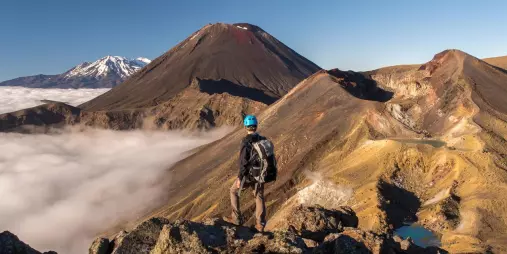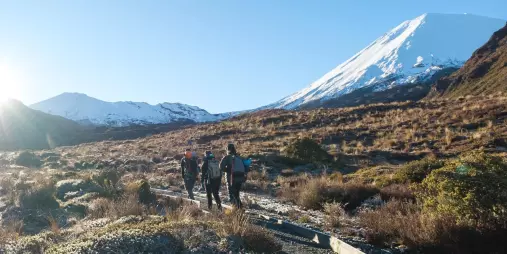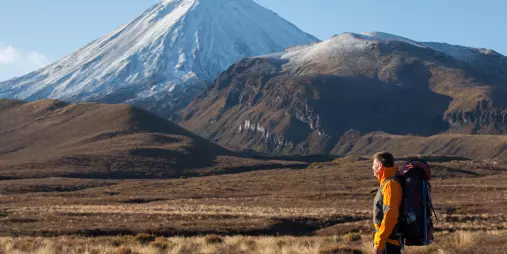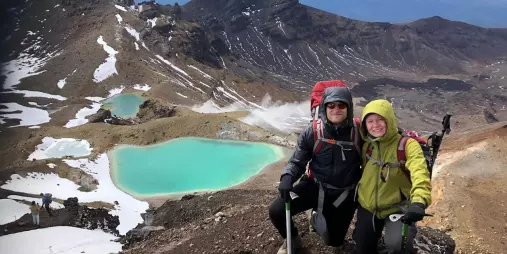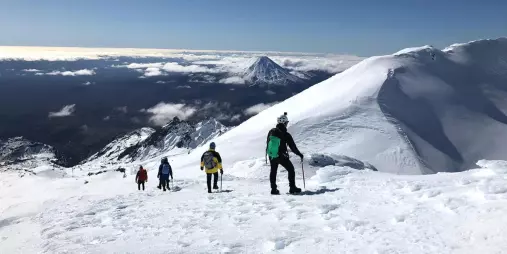Explore New Zealand’s Premier Day Walk
The Tongariro Alpine Crossing is widely regarded as the best one-day hike in New Zealand. This 19.4-kilometre trail leads walkers through the heart of Tongariro National Park, a dual World Heritage Area known for its natural and cultural significance.
The track crosses ancient lava flows, active craters and vivid geothermal landscapes. Along the way, you’ll pass Red Crater, the vibrant Emerald Lakes and Blue Lake, all set against the dramatic backdrop of Mount Tongariro and Mount Ngauruhoe (also known as Mount Doom in The Lord of the Rings).
Plan Ahead for a Safe and Rewarding Hike
The Tongariro Alpine Crossing is a serious mountain walk and should not be underestimated. Weather can change quickly, and alpine conditions mean proper gear, sturdy footwear, and warm layers are essential—even in summer.
Shuttle services operate from National Park Village, Whakapapa and Taupō, providing transport to and from the trailheads. It’s best to start early and check with the Department of Conservation (DOC) for up-to-date track conditions, alerts and safety advice before setting out.
Things to Know for the Tongariro Alpine Crossing
Here are some helpful highlights to plan your Tongariro Alpine Crossing adventure:
- Total distance is 19.4 km (allow 6–8 hours)
- Highlights include Red Crater and Emerald Lakes
- Best walked from Mangatepopo to Ketetahi (one-way)
- Bring layers, waterproof gear and sun protection
- Carry at least 2 litres of water and high-energy snacks
- No drinking water is available on the trail
- Use shuttle services for safe and convenient access
- Check weather and alerts with DOC before hiking
- Avoid walking in winter without alpine experience
- Guided options available for extra safety and insight
Remember, the Tongariro Alpine Crossing is a challenging trek and is subject to extreme weather changes. Good preparation and adherence to safety guidelines are crucial. The crossing is usually walked from Mangatepopo to Ketetahi due to the Mangatepopo end being higher in altitude, reducing the amount of climbing needed.
Tongariro National Park, home to the iconic Tongariro Alpine Crossing, carries profound cultural and historical significance for the Māori people. The dramatic landscape, considered tapu or sacred, is intertwined with Māori mythology, where the mountains are seen as gifts from the gods and serve as significant ancestral mountains for local iwi. In 1887, Māori chief Te Heuheu Tukino IV's gift marked the establishment of Tongariro National Park, the first in New Zealand and among the world's earliest. With a history marked by volcanic activity, the park features lava flows, craters, and thermal areas, earning it dual UNESCO World Heritage Site status in 1990 and 1993 for its natural and cultural values. Today, visitors are encouraged to respect the park's cultural significance and natural beauty, contributing to the preservation of its unique blend of heritage for future generations.
The Tongariro Alpine Crossing in Tongariro National Park boasts resilient flora and fauna adapted to the volcanic landscape. From tussock grasslands to alpine terrain with unique plant species, the changing ecosystems captivate hikers. Descending towards Ketetahi reveals lush vegetation transitioning into podocarp-hardwood forest. The park hosts bird species like the elusive kiwi, while insect life includes the large mountain stone weta. Introduced mammals, such as rabbits and possums, pose challenges, prompting ongoing control efforts. Visitors are urged to respect wildlife by observing from a safe distance and staying on designated paths to preserve the natural surroundings.
Tongariro National Park, a UNESCO World Heritage Site, is protected by New Zealand's Department of Conservation (DOC). Conservation initiatives include species protection for native wildlife, pest control against invasive mammals, fire management, trail maintenance, and visitor education to minimize environmental impact. Cultural conservation efforts involve preserving the park's significance for Māori people. The collective responsibility encourages visitors to adhere to guidelines and respect the unique cultural and natural heritage of the park.
Prepare thoroughly for the Tongariro Alpine Crossing, a demanding 19.4-kilometre trek, considering its length, difficulty, and unpredictable weather. Ensure a good fitness level for steep climbs and descents during the 6-8 hour journey. Dress in layered, weather-appropriate clothing, wear sturdy hiking boots, and bring essentials like sunglasses, a hat, sunscreen, gloves, and a warm hat. Carry ample food and water, as there are no shops along the track, and be mindful of increased hydration needs at higher altitudes. Equip yourself with navigation tools, cheque the weather forecast, and turn back if conditions become hazardous. Pack safety items like a first aid kit, whistle, headlamp, and thermal blanket, and, in winter conditions, include crampons and an ice axe. Adhere to Leave No Trace principles, using toilets at designated points, and inform someone of your plans, emphasising a respectful and well-prepared approach to ensure a safe and enjoyable Tongariro Alpine Crossing experience.
Accessing the Tongariro Alpine Crossing requires careful planning due to the trail's one-way nature, with separate start and finish points. If you have your transportation, you can self-drive to either the Mangatepopo car park (start) or Ketetahi car park (end), noting the 4-hour parking limit imposed by the Department of Conservation. Alternatively, shuttle services provide a convenient solution, offering pickups from accommodations and transporting hikers to the trail's start, with return pickups from the endpoint. It's advisable to book shuttles in advance, especially during peak seasons. Some accommodations may also offer transfer services. Key towns for accommodation and services are National Park Village, Whakapapa Village, Turangi, and Taupo. For guided walks, staying in National Park Village is recommended. As arrangements may change, cheque the latest local information for a smooth and stress-free Tongariro Alpine Crossing experience.
The Tongariro Alpine Crossing, an alpine trek, demands caution due to rapidly changing and severe weather conditions. While highly experienced hikers can attempt it independently, less experienced individuals and day walkers are strongly advised to opt for guided Tongariro Alpine Treks, leveraging the expertise of experienced guiding companies for a safer and more enjoyable journey.
The weather on the crossing is highly unpredictable, with potential for strong winds, heavy rain, and even snow during summer. Winter introduces additional challenges with snow, ice, and sub-zero temperatures, making parts of the track impassable without proper equipment and experience. Regardless of the season, safety remains paramount, and hikers are encouraged to cheque the forecast before embarking and be prepared to turn back if weather conditions deteriorate.

